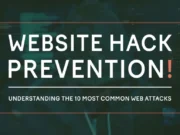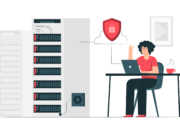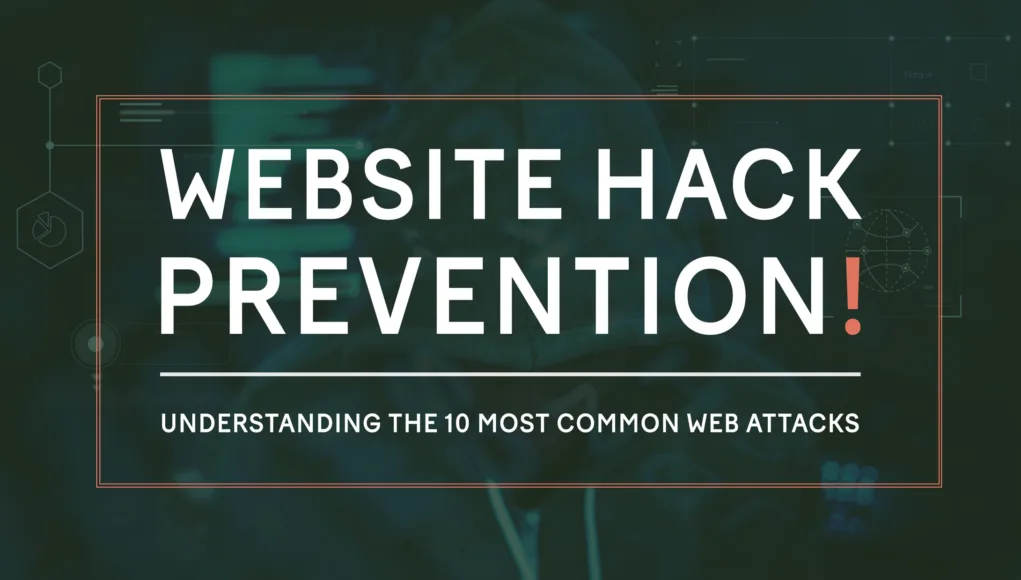Welcome to the wild world of website hacking!
As business owners, it’s important to understand that your website is not just a digital space, it’s your digital home and just like any home, it needs protection.
In this article, we’ll dive into the top 10 most common ways hackers can break into your website and give you the tools to fortify your digital fortress and show you how to how to prevent your website (WordPress, Shopify, or any other) from hacking.
We’re not going to sugarcoat it, website hacking is serious business but we promise to deliver and show you the information in a way you can understand and take necessary steps to prevent your website from hacking. So hold on tight, and let’s get ready to protect your website from the bad guys.
Understanding the most common causes of website hacking
It’s like knowing the weaknesses of your enemy in a game of chess. If you know the common moves and strategies, you can anticipate and defend against them.
Similarly, if you understand the most common ways hackers can break into your website, you can take proactive steps to fortify your digital fortress and protect your business data and website from getting hacked. Plus, it’ll make you feel like a tech-savvy ninja, and who doesn’t want to feel like a tech-savvy ninja? 😀
10 Most Common Reasons Why Websites get Hacked
Here are the top 10 most common reasons why websites get hacked and the ways you can prevent your website from getting hacked. It’s crucial to understand these potential vulnerabilities so you can take proactive measures to secure your website and protect your data.
Remember, precaution is always better than prevention.
1. Weak login credentials
Using weak or easily guessable passwords is one of the most common reasons for website hacking.
Hackers can use automated tools to quickly guess common passwords, use precomputed tables of commonly used passwords known as “rainbow tables” or use a technique called “brute force” which involves trying every possible combination of characters to find the correct password.
Solution: How to create Unhackable Passwords that almost none can crack?
In general, it is recommended to use a combination of uppercase and lowercase letters, numbers, and special characters. Avoid using easily guessable information such as personal information, dates of birth, or common words. And also it’s not recommended to use the same password for multiple accounts.
Here are some examples of strongest passwords you can set:
- 2#t$E@r!oT7u%^W5i&m*p
- p@s5w0rD#1tR3nGtH
- cRaZy#c0mPl3xP@$$w0rd!
2. Using Nulled/Cracked Themes and Plugin
It is one of the major reasons why WordPress websites are hacked. Using nulled or cracked themes and plugins can put your website at risk for hacking for several reasons
Security vulnerabilities: Nulled or cracked themes and plugins may have security vulnerabilities that hackers can exploit to gain access to your website. These vulnerabilities may not have been discovered or patched/fixed by the theme or plugin developer, as the nulled or cracked version is not being updated with the latest security patches/updates.
Malicious code: With nulled or cracked themes and plugins, hackers may insert malicious code or install malware that can be used to steal sensitive data from your website or to use your website for illegal activities.
Malicious code that can be used to steal sensitive information, such as login credentials and customer data, or to install malware on the website.
Lack of support: Websites using nulled or cracked themes and plugins may not have access to the developer’s support and updates, which can leave them vulnerable to new security threats.
Legal Consequences: Using nulled or cracked themes and plugins can also lead to legal consequences. This is because it is illegal to use a nulled or cracked version of a theme or plugin, and website owners can be held liable for copyright infringement.
Overall, using nulled or cracked themes and plugins can significantly increase the risk of a website being hacked, and it is generally better to use the original, paid version of a theme or plugin, which will be updated regularly with the latest security patches. Therefore, prevent your website from getting hacked by not using any Nulled/Cracked plugins or themes.
Solution: Use Always use Paid/Licensed or GPL version of the theme/plugin and prevent WordPress website from hacking
3. Insecure File Permission
Insecure file permissions by allowing unauthorized access to sensitive files, can put websites at risk for hacking.
When a website’s file permission settings are not properly configured, it can leave certain files and folders open for anyone to access, making it super easy for hackers to hack into your website.
For example, if the file permission for a certain folder is set to “777” (which is the maximum level of access), it means that anyone, including hackers, can read, write and execute the files in that folder, which can lead to sensitive information being compromised.
Additionally, a hacker could also use these permissions to upload malicious files to your website and run them, giving them full control of your website. To prevent this, it’s important to make sure that file permissions are set correctly and only giving access to the necessary individuals.
Solution: Setting file permission to keep your website secured from hacking
This can be prevented by setting the file permission for sensitive files and folders to a more restrictive level, such as “644” or “600“. This means that only the owner of the file or folder has the permission to read and write the files, while others (including hackers) do not have any access to the files.
4. Outdated Software
Outdated software can be a major vulnerability when it comes to website security. When software is not kept up to date, it means that any known vulnerabilities in the software are not patched, making it easy for hackers to exploit.
These vulnerabilities can be found in website platforms, content management systems, or plugins, and they can give hackers a way in to steal sensitive information, deface the website, or use it as a launch point for further attacks.
Additionally, outdated software may not have the latest security features, which can make it easier for hackers to bypass the website’s security measures. This is why it’s so important to keep all website software and plugins up to date, including the website platform, content management system, and any additional plugins or add-ons that are used.
Solution: Keep everything updated!!
This ensures that any known vulnerabilities are patched and that the website has the latest security features.
5. Unsecured Remote Access
Remote access refers to the ability to access a website or server from a remote location, which can be really useful for website administrators and developers.
However, if remote access is not properly secured, it can provide an easy way for hackers to gain access to the website’s files and databases, steal sensitive information, or launch other types of attacks.
Imagine leaving your front door open for anyone to come in, that’s what unsecured remote access does to your website. Hackers can exploit it in various ways like guessing or brute-forcing login credentials, exploiting vulnerabilities in the remote access software or protocol.
Solution: To keep your website safe, it’s important to secure remote access by using strong and unique login credentials, and enabling two-factor authentication. This can make it much harder for hackers to gain access.
6. Phishing Scams
Phishing scams are one of the most common ways that hackers can gain unauthorized access to a website. You might have seen this in Hollywood movies, it’s a type of social engineering attack that involves tricking website administrators or users into revealing sensitive information, such as login credentials.
Phishing scams, most of the time take the form of an email that appears to be from a legitimate source such as facebook, google, amazon or your bank, that asks the recipient to click on a link or provide login credentials. The moment you put your login ID & password, it gets sent to the hacker and you are hacked!!
Solution:
Be suspicious of unsolicited messages: Be wary of unsolicited emails, text messages, or phone calls that ask for personal information, even if they seem legitimate.
Verify the authenticity: Before clicking on a link or providing any personal information, make sure to verify the authenticity of the sender and the website.
Keep your software up-to-date: Make sure to keep your computer’s software, including the operating system and web browsers, up-to-date to protect against known security vulnerabilities.
Use two-factor authentication: Use two-factor authentication whenever possible to add an extra layer of security to your accounts (FB, Google, Twitter etc).
Report phishing: If you suspect that you have received a phishing email or message, report it to the appropriate authorities, such as your financial institution or the Federal Trade Commission.
Overall, being cautious and vigilant is key to preventing phishing scams. By being aware of the risks and taking steps to protect yourself, you can reduce the chances of falling victim to a phishing attack.
7. Unsecured Network Connections
Unsecured network connections refer to networks that do not have proper security measures in place, such as public Wi-Fi or an unencrypted network.
When a website administrator or user connects to an unsecured network, their data can be intercepted by hackers through a hacking technique called Man-in-the-middle attack (MITM), who can then use this information to gain access to the website and steal sensitive information, deface the website, or use it as a launch point for further attacks such as DDoS/DoS.
Solution: Do not use Public/Open Wifi to login to the website backend for any reaason
8. Malware Attack
Malware is essentially a type of software that is specifically designed to take over, damage or exploit a website. This can be in the form of viruses, trojans, ransomware or other types of malicious code.
Hackers can use various methods to deliver the malware to a website, such as:
Email attachments: Hackers can send an email with a malware-infected attachment, which when opened, will install the malware on the recipient’s computer.
Drive-by-downloads: Hackers can also infect a website with malware by exploiting vulnerabilities in the website’s software or plugins. When a user visits the infected website, the malware is automatically downloaded and installed on the user’s computer.
Malvertising: Hackers can also use infected ads to deliver malware to a website. When a user clicks on the infected ad, the malware is downloaded and installed on the user’s computer.
Social Engineering: hackers can use social engineering techniques to trick website administrator into installing malware on their website.
Solution: Tighten up all the loose-ends security loopholes. Follow all the security measures recommended in this article.
10. Third-Party Integrations/ Services
Third-party services are often not under the control of the website owner and may not be kept up-to-date with the latest security patches. Therefore, these apps and integrations can put your website at risk for hacking because they may have security vulnerabilities that can be exploited by hackers.
If a third-party service is hacked, it can provide a way for hackers to gain access to websites which are integrated with that service.
For example, if a website uses a third-party analytics service that is hacked, the hacker can access the data collected by that service, which may include sensitive information such as login credentials and customer data.
If a website uses a third-party payment gateway that is hacked, the hacker can use this to steal credit card information and other sensitive data from customers.
Solution: To prevent this type of attack, it’s important to use third-party services from reputable providers which are globally accepted.
Conclusion
It is important for you to understand that security is an ongoing process that requires constant monitoring and updating to stay ahead of new and evolving threats. By being aware of the potential risks and taking the necessary precautions, you can greatly reduce the likelihood of your website being hacked and protect your valuable data and reputation.












9. Social Engineering
A tactic used by hackers to trick people into revealing sensitive information or taking actions that can compromise a website’s security. It’s a type of psychological manipulation that relies on human error, rather than technical vulnerabilities.
Hackers use various techniques to manipulate people into providing sensitive information, such as login credentials, or into taking actions that can compromise a website’s security. Some common tactics include phishing scams, spear-phishing, baiting, and pretexting.
For example, a hacker may call or message pretending to be a representative of a company or organization, asking for personal information or login credentials.
Solution: Like the Awareness emails & messages you get from your bank “Do not share any OTP or any other confidential information with anyone unless you have verified their authenticity”